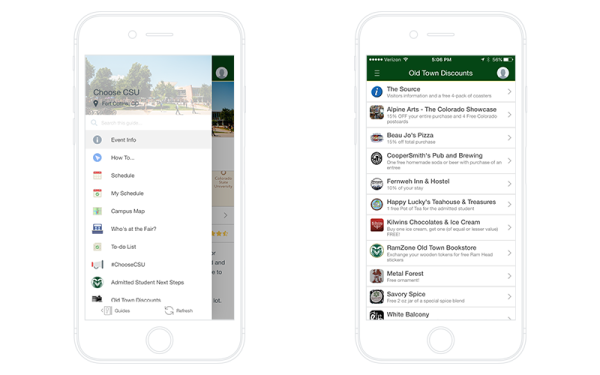The 3 Elements of an Admissions Mobile App Strategy
Prospective students are looking for information on their mobile phones. Are you prepared to deliver with an admissions app?
Thousands of students pass through your campus looking for the perfect place to call home for the next four or more years. Admissions offices know that most of those students are consuming content on their smartphones, and the offices that are taking advantage of this fact have created a dedicated admissions app to amplify their message.
But what exactly does an admissions mobile app look like? What is the content? And is there a standard strategy for assembling this new type of communication channel?
At Guidebook we’ve seen some of the most innovative admissions teams in the country use mobile communication with great success – to reach more students, extend the staying-power of their message, and connect in new ways – and we’ve boiled the steps to get there down to 3 considerations.
1. Define your audiences
Admissions offices talk to many different groups of prospective students throughout the year, and each is deserving of its own message. By getting specific about who you are trying to reach with an admissions app, you’ll do yourself the favor of knowing exactly how to structure your content.

Colorado State University’s admissions app
Colorado State University is currently using an admissions app to deliver their recruitment message to several populations throughout the year. They knew from the start that they had three audiences they wanted to reach – high school juniors for their Discover program, admitted seniors for their Choose program, and everyday campus visitors. By putting their audiences into these three buckets, it became clear that they needed to create three different sets of information.
“Our app gives us another touchpoint beyond just a conversation.” -Erika Ryan, Senior Assistant Director, Admissions, Colorado State University
As a result, CSU has created separate Guidebook Guides within their admissions app for both their Discover and Choose programs, and one for everyday visitors is on the way. Now the CSU team can communicate the appropriate message to each audience individually.
2. Focus the content
At the heart of an effective admissions app is the content inside of it. Without a focused and intent-driven message, you won’t be able to expect much from its implementation. Because the app is a self-contained communication channel, it’s worth putting some thought into a cohesive narrative that will influence the content of your app as a whole.
CSU knows that the city of Fort Collins has a lot to offer its population, so introducing prospective students to the community became a major throughline of the content in their guide for admitted students. An entire section is dedicated to local discounts from neighborhood retailers.

CSU used their Choose guide to highlight the benefits of living in Fort Collins.
In addition to local vendors, there is a robust informational section where prospective students can learn about the area, it’s rich outdoor offerings, and even get up to speed on the local music scene. This rounded content – in addition to the traditional maps, schedules, and FAQs – ensures that the admissions app becomes a destination beyond just a digital version of the paper program. CSU has found a way to match students’ digital expectations with content that meets their needs and takes an extra step which encourages them to explore.
3. Take advantage of the format
A benefit of creating an admissions app is that you’re not only allowing yourself a new channel of communication, but that you’re creating a context for that communication. Mobile apps allow you a certain level of reach, interactivity, and immediacy that may not have existed for you in the past.
“I’m incredibly interested in how we can get people to think about how they can make the most of their visit before we’re in front of them” -Erika Ryan, Senior Assistant Director, Admissions, Colorado State University
Perhaps most importantly, an admissions app is going to help extend the life of your content with proper promotion. If the app is a source for need-to-know information, your audiences will be eager to download it before they’re ever on campus. Likewise, as students continue their decision-making process throughout the year, they’re likely to refer back to the content as well. As a result, you’ve created a captive audience and an instantly updateable communication channel with which to to reach them!
Within your admissions app, it’s also worth considering the function of the type of guide you choose to present to each audience. With events-based populations (such as an admitted student day) you can tie your guide to a specific schedule to events. If your plan is to use a guide for an ongoing year-round conversation, it might make more sense to free yourself of a schedule and structure it to focus on general campus information and FAQs. And now with Guidebook’s self-led mobile tours, you can create a guide specifically for students who are touring your campus in realtime.
It’s also great to remember that the fact that you’re offering an admissions app in the first place speaks volumes about your school’s values. There is absolutely a sustainability component (coupled with a cost-savings advantage) – but ultimately choosing to make mobile communication one of your main channels tells students that you care about meeting them where they are, and that you value easily-accessible information. By reducing friction to the information they want in an on-demand way, you’re also creating fans in the meantime.



